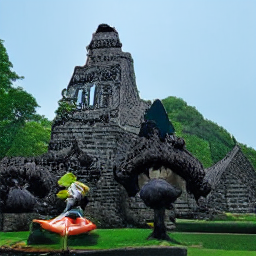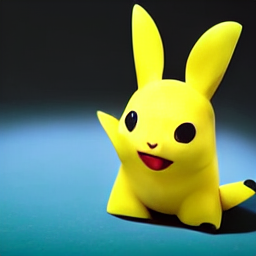glid-3-xl
Maintainer: jack000

45

| Property | Value |
|---|---|
| Run this model | Run on Replicate |
| API spec | View on Replicate |
| Github link | View on Github |
| Paper link | View on Arxiv |
Create account to get full access
Model overview
glid-3-xl is a 1.4B parameter text-to-image model developed by CompVis and fine-tuned by jack000. It is a back-ported version of CompVis' latent diffusion model to the guided diffusion codebase. Unlike the original stable-diffusion model, glid-3-xl has been split into three checkpoints, allowing for fine-tuning on new datasets and additional tasks like inpainting and super-resolution.
Model inputs and outputs
The glid-3-xl model takes in a text prompt, an optional init image, and various parameters to control the image generation process. It outputs one or more generated images that match the given text prompt.
Inputs
- Prompt: Your text prompt describing the image you want to generate.
- Negative Prompt: (Optional) Text to negatively influence the model's prediction.
- Init Image: (Optional) An initial image to use as a starting point for the generation.
- Seed: (Optional) A seed value for the random number generator.
- Steps: The number of diffusion steps to run, controlling the quality and detail of the output.
- Guidance Scale: A value controlling the trade-off between faithfulness to the prompt and sample diversity.
- Width/Height: The target size of the generated image.
- Batch Size: The number of images to generate at once.
Outputs
- Image(s): One or more generated images that match the given text prompt.
Capabilities
glid-3-xl is capable of generating high-quality, photorealistic images from text prompts. It can handle a wide range of subjects and styles, from realistic scenes to abstract and surreal compositions. The model has also been fine-tuned for inpainting, allowing you to edit and modify existing images.
What can I use it for?
You can use glid-3-xl to generate custom images for a variety of applications, such as:
- Illustration and concept art
- Product visualizations
- Social media content
- Advertising and marketing materials
- Educational resources
- Personal creative projects
The ability to fine-tune the model on new datasets also opens up possibilities for domain-specific applications, such as generating medical illustrations or architectural visualizations.
Things to try
One interesting aspect of glid-3-xl is the ability to use an init image and apply human-guided diffusion to iteratively refine the generation. This allows you to start with a basic image and progressively edit it to better match your desired prompt. You can also experiment with the various sampling techniques, such as PLMS and classifier-free guidance, to find the approach that works best for your use case.
This summary was produced with help from an AI and may contain inaccuracies - check out the links to read the original source documents!
Related Models

glid-3

3
glid-3 is a combination of OpenAI's GLIDE, Latent Diffusion, and CLIP. It uses the same text conditioning as GLIDE, but instead of training a new text transformer, it uses the existing one from OpenAI CLIP. Instead of upsampling, it does diffusion in the latent diffusion space and adds classifier-free guidance. Similar models include glid-3-xl-stable, which has more powerful in-painting and out-painting capabilities, and glid-3-xl, which is a CompVis latent-diffusion text2im model fine-tuned for inpainting. Another related model is icons, which is fine-tuned to generate slick icons and flat pop constructivist graphics. The well-known stable-diffusion is also a similar latent text-to-image diffusion model. Model inputs and outputs glid-3 takes in a text prompt and outputs a generated image. The model can generate images quickly, though the image quality may not be ideal as the model is still a work in progress. Inputs Prompt**: The text prompt describing the image you want to generate. Negative**: An optional negative prompt to guide the model away from generating certain elements. Batch Size**: The number of images to generate at once, up to 20. Outputs Array of image URLs**: The generated images, returned as an array of image URLs. Capabilities glid-3 can generate a wide variety of photographic images based on text prompts. While it may not work as well for illustrations or artwork, it can create compelling images of scenes, objects, and people described in the prompt. What can I use it for? You can use glid-3 to quickly generate images for various applications, such as marketing materials, blog posts, social media, or even as a creative tool for ideation. The model's ability to translate text into visual concepts can be a powerful asset for content creators and designers. Things to try One interesting aspect of glid-3 is its use of latent diffusion, which allows for more efficient generation compared to upsampling approaches. You could experiment with different prompts and techniques, such as using classifier-free guidance, to see how it affects the quality and creativity of the generated images.
Updated Invalid Date

glid-3-xl

7
The glid-3-xl model is a text-to-image diffusion model created by the Replicate team. It is a finetuned version of the CompVis latent-diffusion model, with improvements for inpainting tasks. Compared to similar models like stable-diffusion, inkpunk-diffusion, and inpainting-xl, glid-3-xl focuses specifically on high-quality inpainting capabilities. Model inputs and outputs The glid-3-xl model takes a text prompt, an optional initial image, and an optional mask as inputs. It then generates a new image that matches the text prompt, while preserving the content of the initial image where the mask specifies. The outputs are one or more high-resolution images. Inputs Prompt**: The text prompt describing the desired image Init Image**: An optional initial image to use as a starting point Mask**: An optional mask image specifying which parts of the initial image to keep Outputs Generated Images**: One or more high-resolution images matching the text prompt, with the initial image content preserved where specified by the mask Capabilities The glid-3-xl model excels at generating high-quality images that match text prompts, while also allowing for inpainting of existing images. It can produce detailed, photorealistic illustrations as well as more stylized artwork. The inpainting capabilities make it useful for tasks like editing and modifying existing images. What can I use it for? The glid-3-xl model is well-suited for a variety of creative and generative tasks. You could use it to create custom illustrations, concept art, or product designs based on textual descriptions. The inpainting functionality also makes it useful for tasks like photo editing, object removal, and image manipulation. Businesses could leverage the model to generate visuals for marketing, product design, or even custom content creation. Things to try Try experimenting with different types of prompts to see the range of images the glid-3-xl model can generate. You can also play with the inpainting capabilities by providing an initial image and mask to see how the model can modify and enhance existing visuals. Additionally, try adjusting the various input parameters like guidance scale and aesthetic weight to see how they impact the output.
Updated Invalid Date

sdxl-lightning-4step

409.9K
sdxl-lightning-4step is a fast text-to-image model developed by ByteDance that can generate high-quality images in just 4 steps. It is similar to other fast diffusion models like AnimateDiff-Lightning and Instant-ID MultiControlNet, which also aim to speed up the image generation process. Unlike the original Stable Diffusion model, these fast models sacrifice some flexibility and control to achieve faster generation times. Model inputs and outputs The sdxl-lightning-4step model takes in a text prompt and various parameters to control the output image, such as the width, height, number of images, and guidance scale. The model can output up to 4 images at a time, with a recommended image size of 1024x1024 or 1280x1280 pixels. Inputs Prompt**: The text prompt describing the desired image Negative prompt**: A prompt that describes what the model should not generate Width**: The width of the output image Height**: The height of the output image Num outputs**: The number of images to generate (up to 4) Scheduler**: The algorithm used to sample the latent space Guidance scale**: The scale for classifier-free guidance, which controls the trade-off between fidelity to the prompt and sample diversity Num inference steps**: The number of denoising steps, with 4 recommended for best results Seed**: A random seed to control the output image Outputs Image(s)**: One or more images generated based on the input prompt and parameters Capabilities The sdxl-lightning-4step model is capable of generating a wide variety of images based on text prompts, from realistic scenes to imaginative and creative compositions. The model's 4-step generation process allows it to produce high-quality results quickly, making it suitable for applications that require fast image generation. What can I use it for? The sdxl-lightning-4step model could be useful for applications that need to generate images in real-time, such as video game asset generation, interactive storytelling, or augmented reality experiences. Businesses could also use the model to quickly generate product visualization, marketing imagery, or custom artwork based on client prompts. Creatives may find the model helpful for ideation, concept development, or rapid prototyping. Things to try One interesting thing to try with the sdxl-lightning-4step model is to experiment with the guidance scale parameter. By adjusting the guidance scale, you can control the balance between fidelity to the prompt and diversity of the output. Lower guidance scales may result in more unexpected and imaginative images, while higher scales will produce outputs that are closer to the specified prompt.
Updated Invalid Date

glid-3-xl-stable

13
glid-3-xl-stable is a variant of the Stable Diffusion text-to-image AI model, developed by devxpy. It builds upon the original Stable Diffusion model by adding more powerful in-painting and out-painting capabilities. This allows users to seamlessly edit and extend existing images based on text prompts. Model inputs and outputs glid-3-xl-stable takes text prompts as input and generates high-quality images as output. It can also take an initial image and a mask as input to perform targeted in-painting or out-painting. Inputs Prompt**: The text prompt describing the desired image Init Image**: An optional initial image to use as a starting point Mask**: An optional mask image to define the area to be in-painted or out-painted Outputs Generated Image(s)**: One or more images generated based on the input prompt and optional initial image and mask Capabilities In addition to the standard text-to-image generation capabilities of Stable Diffusion, glid-3-xl-stable offers enhanced in-painting and out-painting features. This allows users to seamlessly edit and extend existing images by providing a text prompt and a mask. The model can also perform classifier-guided generation to produce images that align with specific visual styles, such as anime, art, or photography. What can I use it for? glid-3-xl-stable can be used for a variety of applications, including: Creative Image Editing**: Enhance or modify existing images by in-painting or out-painting based on text prompts. Conceptual Artwork Generation**: Generate unique and imaginative artworks by providing text descriptions. Product Visualization**: Create realistic product renderings by combining 3D models with text-based descriptions. Photo Editing and Manipulation**: Remove unwanted elements from images or add new content based on text prompts. Things to try One interesting use case for glid-3-xl-stable is the ability to perform classifier-guided generation. By providing a text prompt along with a specific classifier (e.g., for anime, art, or photography), the model can generate images that align with the desired visual style. This can be particularly useful for creating conceptual artwork or for exploring different artistic interpretations of a given idea. Another compelling feature is the model's out-painting capability, which allows users to extend the canvas of an existing image. This can be useful for tasks such as creating panoramic images, generating larger-scale artwork, or expanding the background of a scene.
Updated Invalid Date